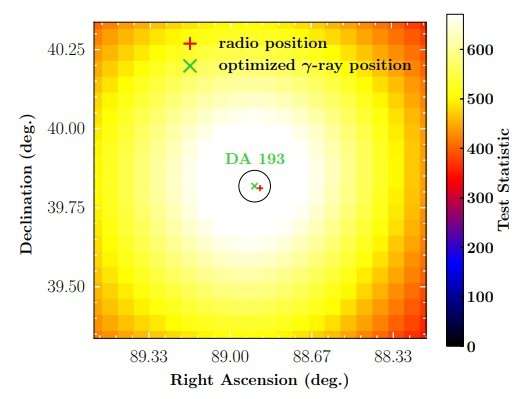January 3, 2019 report
Luminous gamma-ray flare detected from the blazar DA 193

An international group of astronomers has detected an intense and extremely luminous gamma-ray flare from one of high-redshift blazars known as DA 193. The new detection, reported in a paper published December 18 on arXiv.org, is an uncommon finding as such bright flares are rarely observed from high-redshift sources.
Blazars, classified as members of a larger group of active galaxies that host active galactic nuclei (AGN), are the most numerous extragalactic gamma-ray sources. Their characteristic features are relativistic jets pointed almost exactly toward the Earth. In general, blazars are perceived by astronomers as high-energy engines serving as natural laboratories to study particle acceleration, relativistic plasma processes, magnetic field dynamics and black hole physics.
Studies show that high-redshift blazars (with redshifts above 2.0) hosting massive black holes and the most powerful relativistic jets are the most luminous ones. Finding and observing new blazars at high redshifts could be crucial for providing insights into many phenomena of the universe, including the evolution and space density of massive black holes.
A team of researchers led by Vaidehi S. Paliya of DESY research center in Zeuthen, Germany, investigated one such high-redshift blazar. They used the Large Area Telescope (LAT) on board NASA's Fermi Gamma-ray Space Telescope and other instruments to characterize physical properties DA 193 – a blazar observed close to the galactic anti-center at a redshift of approximately 2.36. These observations resulted in the detection of significant gamma-ray emission from this object.
"In this work, we present the results of our study on another high-redshift blazar DA 193 (also known as 0552+398; z = 2.363, Wills & Wills 1976; McIntosh et al. 1999) which we have found as a new gamma-ray emitting object through our detailed Fermi-LAT analysis," the researchers wrote in the paper.
DA 193 underwent a significant GeV flare in the first week of 2018. According to the study, it was an extremely luminous gamma-ray flare with a luminosity of about 130 quindecillion erg/s.
The researchers note that such a GeV flare from a high-redshift blazar is a rare phenomenon. This is due to the fact that these blazars are generally faint in the gamma-ray band.
Notably, DA 193 has an extremely hard gamma-ray spectrum. "What makes this event a rare one is the observation of an extremely hard γ-ray spectrum (photon index = 1.7 ± 0.2), which is somewhat unexpected since high-redshift blazars typically exhibit a steep falling spectrum at GeV energies," the paper reads.
Trying to determine what caused such an intense and luminous flare from DA 193, the astronomers suggest that a change in the behavior of the underlying electron population could be responsible for the observed event. The team intends to use LAT for further continuous monitoring of the gamma-ray sky in order to find more powerful blazars showcasing luminous flares like DA 193. Studying such events could lead to a better understanding of radiative processes powering relativistic jets in blazars.
More information: Vaidehi S. Paliya et al. Detection of a gamma-ray flare from the high-redshift blazar DA 193. arXiv:1812.07350 [astro-ph.HE] arxiv.org/abs/1812.07350
© 2019 Science X Network





















